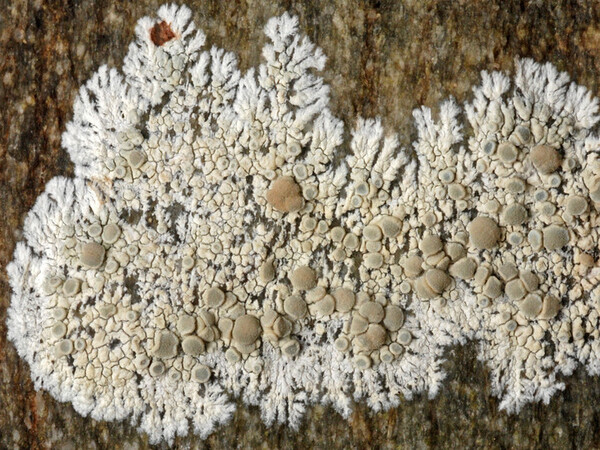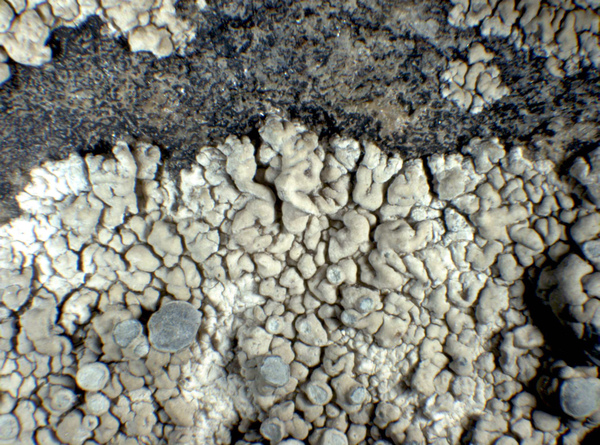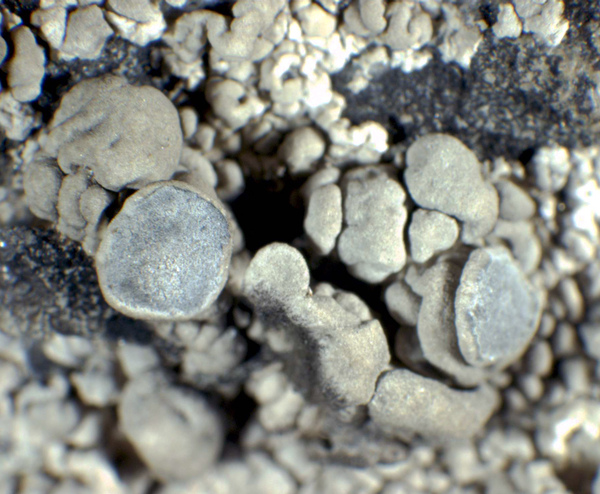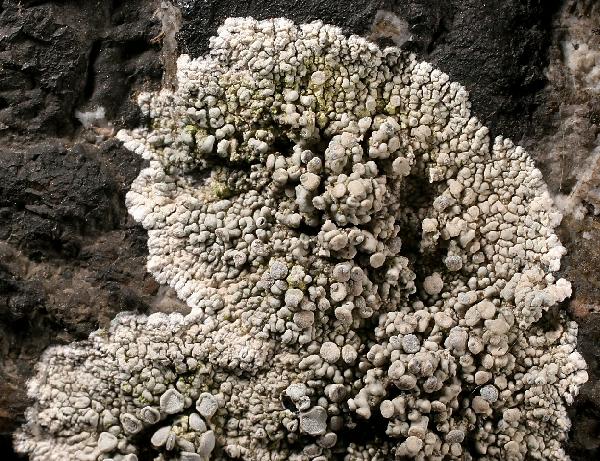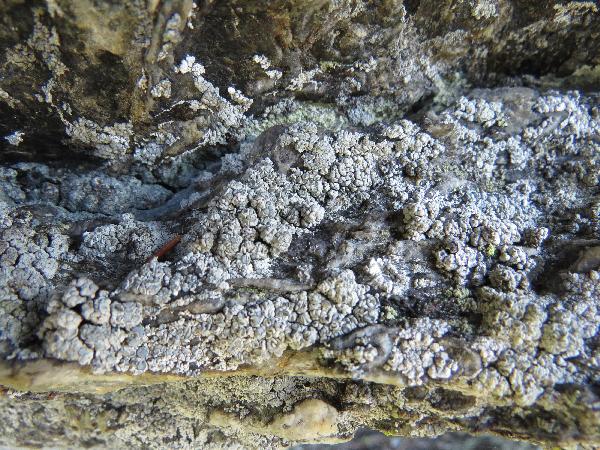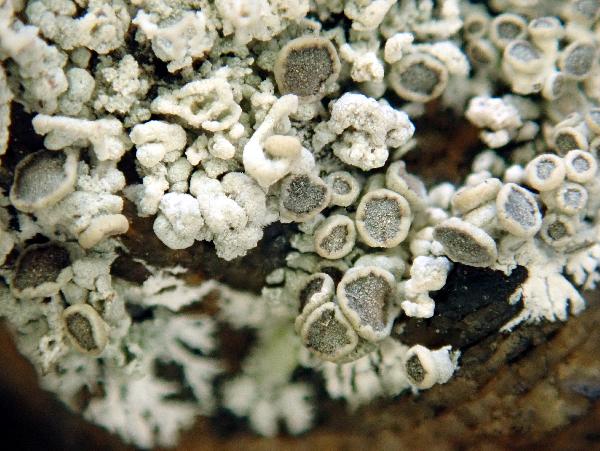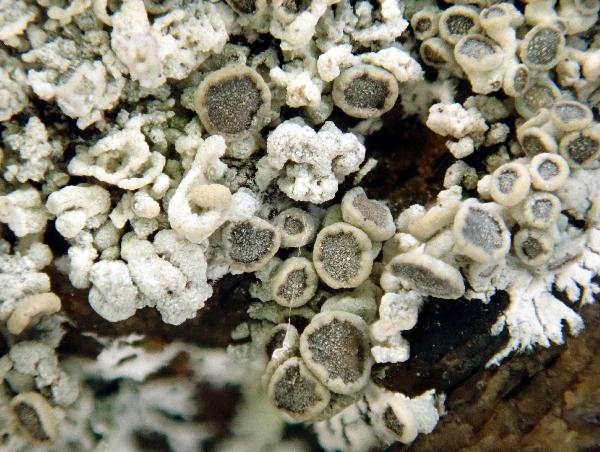Glaucomaria swartzii (Ach.) S.Y. Kondr., Lőkös & Farkas subsp. swartzii
Stud. Bot. Hungar., 61, 1-2: 154, 2019. Basionym: Lichen swartzii Ach. - K. Vetensk.-Akad. Nya Handl.: 185, 1794.
Synonyms: Lecanora glaucoma var. swartzii (Ach.) Nyl.; Lecanora pachycarpa Samp.; Lecanora rupicola var. leucogaea (Ach.) R. Sant.; Lecanora sordida var. swartzii (Ach.) Rabenh.; Lecanora subradiosa auct. non Nyl.; Lecanora swartzii (Ach.) Ach. subsp. swartzii; Zeora sordida var. swartzii (Ach.) Körb.
Description: Thallus crustose, episubstratic, rimose to verrucose-areolate, white to cream-coloured, smooth, usually white-pruinose, often forming orbicular rosettes delimited by a white, more or less arachnoid prothallus, sometimes almost placodioid. Areoles flat to finally strongly convex and more or less hollow, thick, ecorticate, the peripheral ones often elongate and more or less radiating. Apothecia lecanorine, constricted at base to almost stalked, 0.3-1.5 mm across, with a brown or grey-brown, but heavily white- or bluish grey-pruinose, flat to convex disc, and a thin, even, smooth thalline margin, with or without an inner, blackish parathecial ring. Thalline exciple with an algal-free, strongly conglutinated eucortex and a more or less loose medullar plectenchyma in inner parts; proper exciple colourless, containing crystals soluble in K; epithecium brown to dark brown, with crystals, the pigment and the crystals dissolving in K; hymenium colourless; paraphyses slightly thickened at tips; hypothecium colourless. Asci 8-spored, elongate-clavate, very thin-walled, with a K/I+ blue, tall tholus penetrated by a faintly amyloid apical cushion, the wall K/I-, surrounded by a K/I+ blue outer layer, Lecanora-type. Ascospores 1-celled, hyaline, ellipsoid, 9-14 x 6-7.5 µm. Photobiont chlorococcoid. Spot tests: thallus K+ yellow, C+ yellow, KC+ orange, P+ pale yellow; apothecial disc (pruina) C+ bright yellow to orange. Chemistry: atranorin (major), chloroatranorin (minor), eugenitol (minor), roccellic acid (major), and sordidone (major).
Growth form: Crustose
Substrata: rocks
Photobiont: green algae other than Trentepohlia
Reproductive strategy: mainly sexual
In underhangs rarely wetted by rain
Commonnes-rarity: (info)
Alpine belt: rather common
Subalpine belt: common
Montane belt: very rare
Dry submediterranean belt: absent
Humid submediterranean belt: absent
Padanian area: absent
pH of the substrata:
1 2 3 4 5
Solar irradiation:
1 2 3 4 5
Aridity:
1 2 3 4 5
Eutrophication:
1 2 3 4 5
Poleotolerance:
0 1 2 3
Altitudinal distribution:
1 2 3 4 5 6
Rarity
absent
extremely rare
very rare
rare
rather rare
rather common
common
very common
extremely common
Loading data...
Occurrence data
Predictive map
Growth form: Crustose
Substrata: rocks
Photobiont: green algae other than Trentepohlia
Reproductive strategy: mainly sexual
In underhangs rarely wetted by rain
Commonnes-rarity: (info)
Alpine belt: rather common
Subalpine belt: common
Montane belt: very rare
Dry submediterranean belt: absent
Humid submediterranean belt: absent
Padanian area: absent
pH of the substrata:
| 1 | 2 | 3 | 4 | 5 |
Solar irradiation:
| 1 | 2 | 3 | 4 | 5 |
Aridity:
| 1 | 2 | 3 | 4 | 5 |
Eutrophication:
| 1 | 2 | 3 | 4 | 5 |
Poleotolerance:
| 0 | 1 | 2 | 3 |
Altitudinal distribution:
| 1 | 2 | 3 | 4 | 5 | 6 |
Rarity
absent
extremely rare
very rare
rare
rather rare
rather common
common
very common
extremely common
Loading data...
Occurrence data
Predictive map


